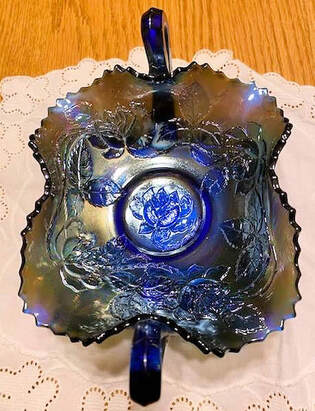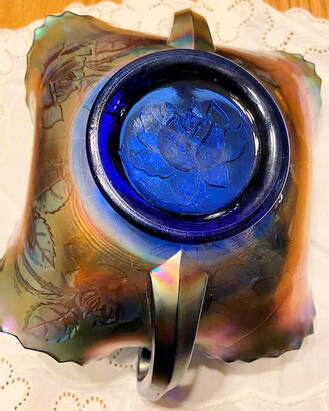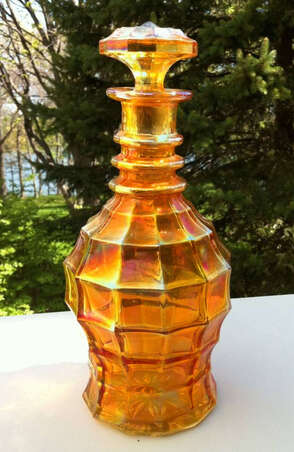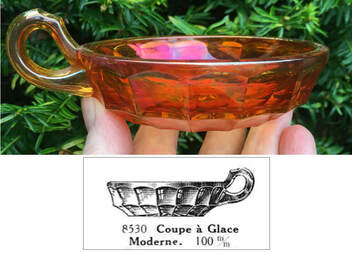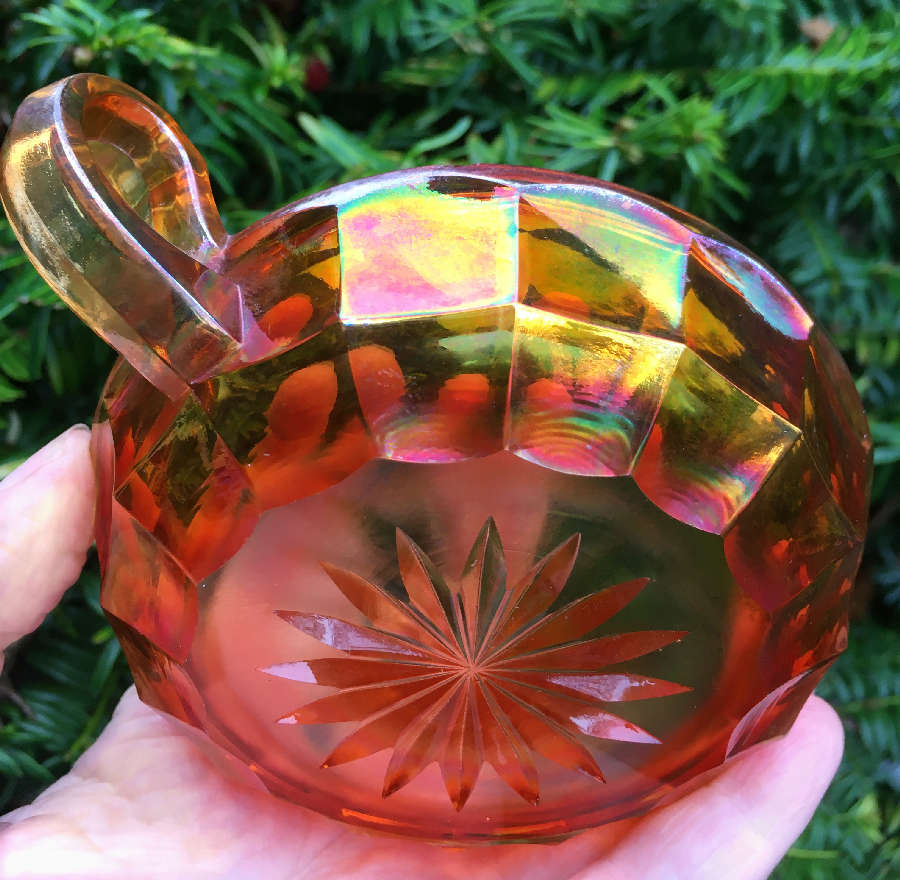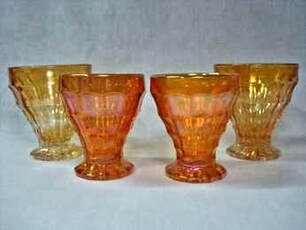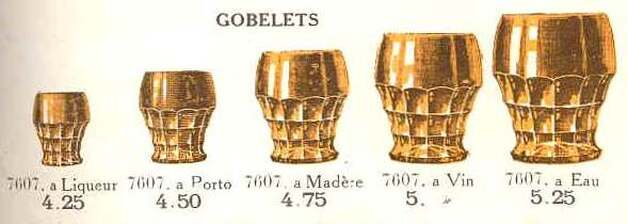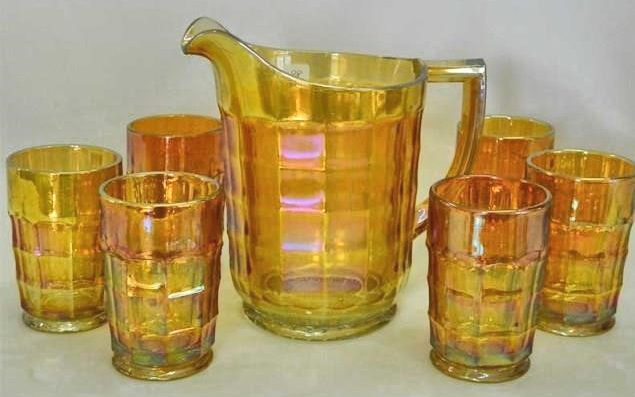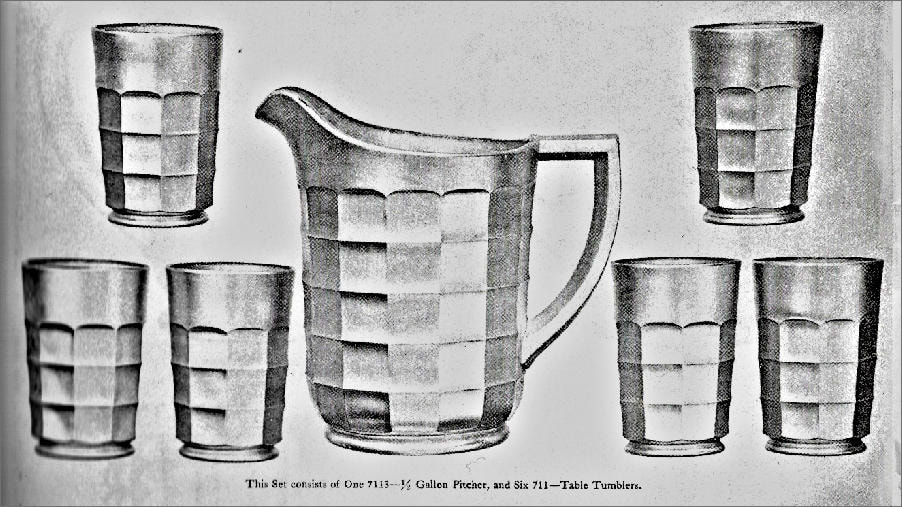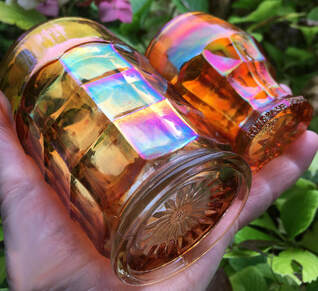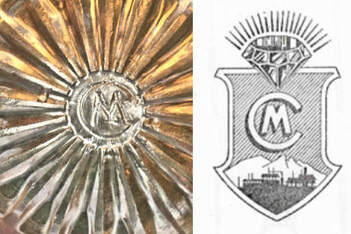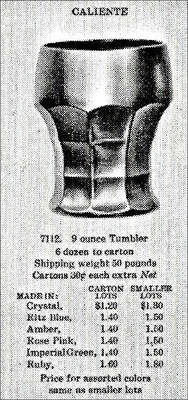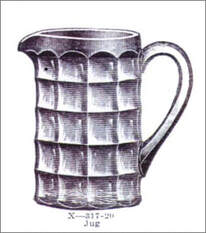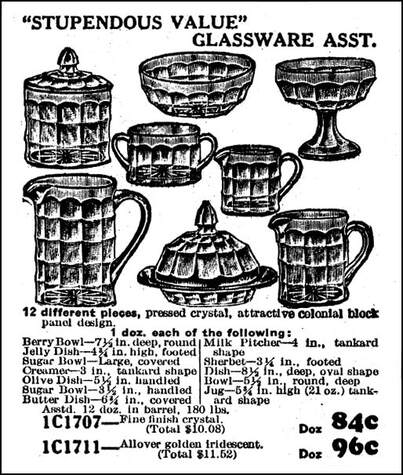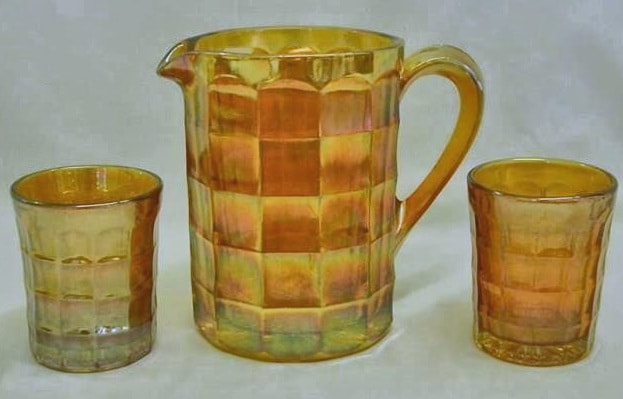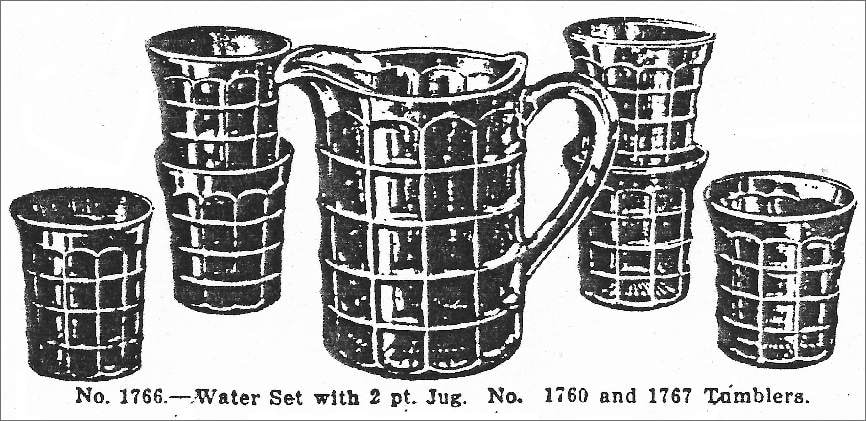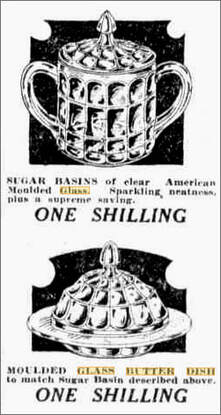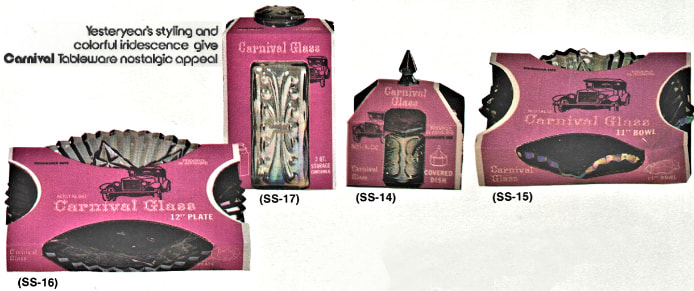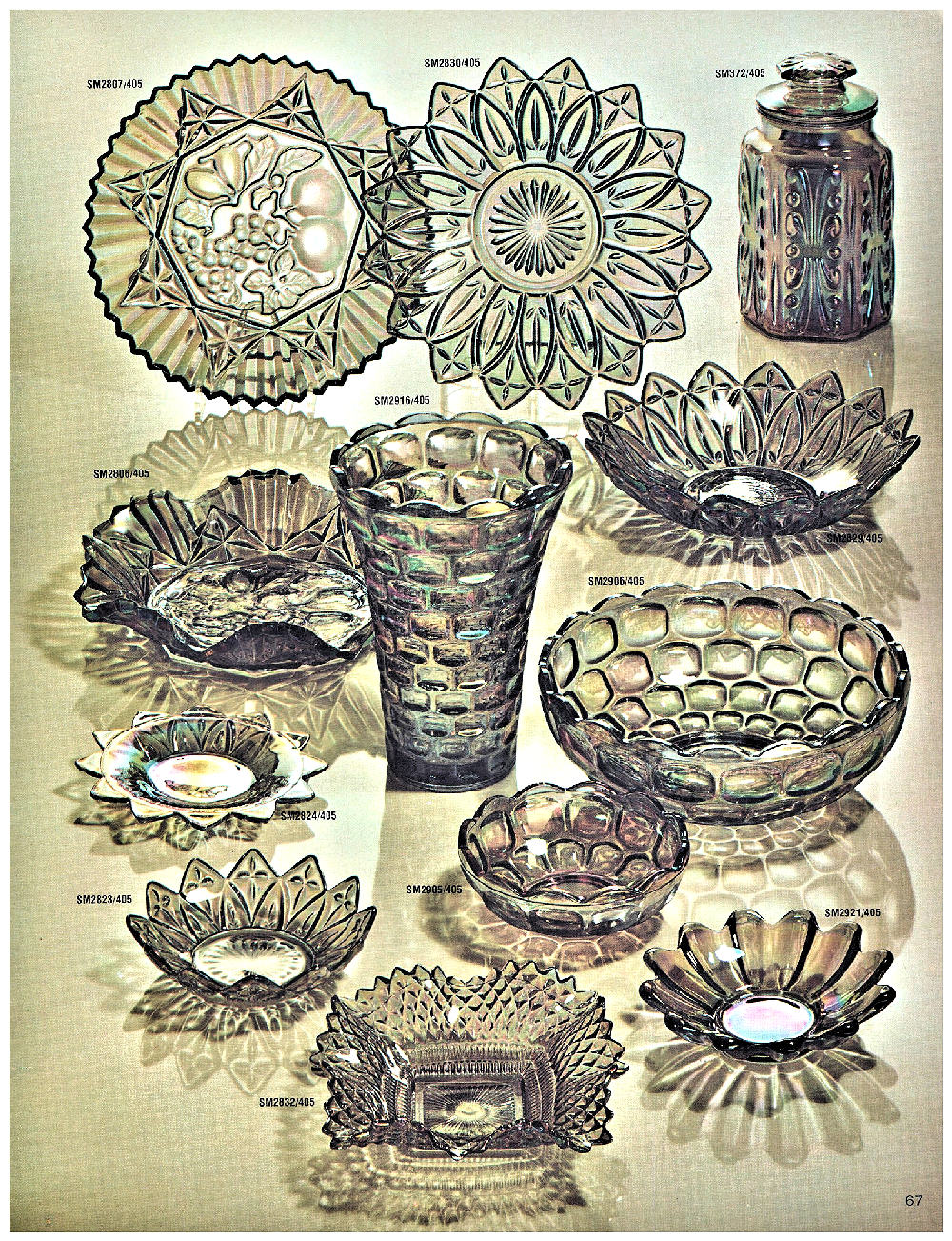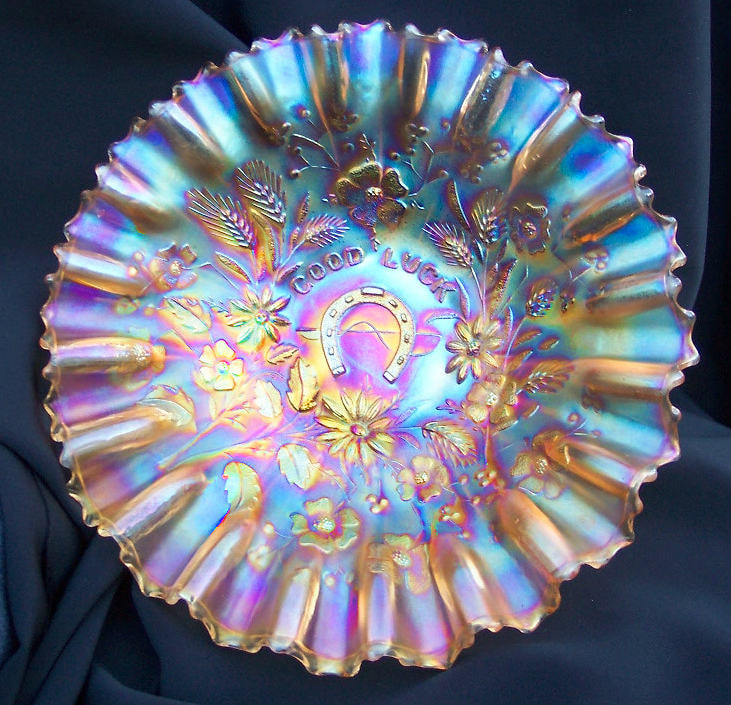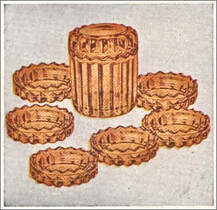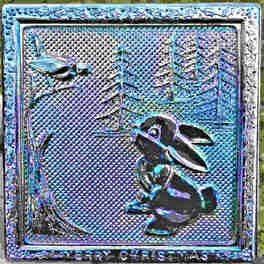NetworK ezine Issue 79. December 2021
Totally Devoted to Carnival Glass
We have an extra-full, packed December edition of NetworK for you – something to give you plenty of reading and enjoyment that you can dip into during the holidays and beyond. Lots of illustration, as always, and some of the detailed images can also be seen large size (just click to be taken to a full page on our website where you’ll see a bigger version of the picture). Now, let’s begin this issue with a fabulous discovery!
|
Rose Bouquet Pictures courtesy of Michelle and Craig Dick. This beautiful handled bon-bon is a magnificent recent “find” by NetworK members, Michelle and Craig Dick. They had spotted it in an upcoming estate sale and attended the event with their fingers tightly crossed. They were over-joyed and so excited when this beauty became theirs, as they had identified it as the very rare Fenton “Rose Bouquet” bon-bon. And isn’t it gorgeous! As Michelle said, when they added it to their collection: “the Carnival Glass gods were watching over us”. Our understanding is that only one other blue example is currently known. The first blue one was reported back in 2006. White examples are also known, but are scarce. A great find! |
Jacobean and Followers
Inwald (Czechoslovakia). Introduced by Inwald in 1921 (and originally called “Lord” by its Czech maker) this incredibly popular line of glass tableware was named “Jacobean” by the British wholesaler Clayton Mayers, who also registered the design in the UK.
Inwald (Czechoslovakia). Introduced by Inwald in 1921 (and originally called “Lord” by its Czech maker) this incredibly popular line of glass tableware was named “Jacobean” by the British wholesaler Clayton Mayers, who also registered the design in the UK.
|
A magnificent Inwald “Lord” aka “Jacobean” decanter and stopper.
|
It’s a tale of double genius! First, the creative artistry of Rudolf Schroetter, who designed the pattern and its adaption on around 300 different shapes – and secondly, the commercial ingenuity and vision of the wholesaler, Clayton Mayers, who made the line into a best-selling, household name. Shown on the left is a magnificent Inwald “Lord” aka “Jacobean” decanter and stopper. And here is a previously un-reported shape in Inwald’s “Jacobean” - a beautiful, handled ice cream dish (coupe à glace). It has Inwald’s signature characteristics of a superb iridescence, showing deep pinks, gold and turquoise, and a high quality, mirror-shiny, ground base with a deeply incised star. Note the elegant and stylish shape, and its uniquely formed handle (with a flat edge on the top, to rest the thumb). |
In essence, Inwald’s “Jacobean” is a simple block pattern – but what made Inwald’s Carnival version so lovely and so sought-after, is the unique combination of the fluid elegance of the shapes coupled with outstanding iridescence and top-notch quality. The genius of the designer was his ability to create fascinating and elegant forms, often with unique accents, that elevate simplicity into “Grand Design”.
|
The simple block motif of the Jacobean pattern is often mis-identified as other patterns can be confused with it. Those who read and learn, however, know that Inwald’s glass is usually characterised by a mirror-shiny ground base – an easy identifier. Unfortunately, it is often mis-named as “Ranger” or “Jacobean Ranger”. So please call it by its proper name – “Lord” or “Jacobean”. Don’t call it “Ranger” – because it isn’t! Inwald added another shape of tumbler to their Carnival line that is seldom seen. We can show them to you, thanks to this picture (below) sent to us by Claudio Deveikis. |
Above: Inwald’s “Jacobean” water pitcher and six sizes of tumbler, as shown in the French wholesaler, Markhbeinn’s, catalogue. Five of these sizes were iridised (irisé). Those five are shown in the Markhbeinn ad below – the very large beer (bière) size was not made in Carnival. Note that Markhbeinn changed the original Inwald name “Lord” to “Milord” (meaning “My Lord”).
|
You can also see many more amazing Inwald catalogue illustrations in this very full Collectors Facts: Jacobean (aka Lord, aka Milord), Josef Inwald
Imperial (USA)
Popular designs were often copied by other glassworks, and several other companies made their own version of Inwald's “Jacobean”. Imperial made a version called “Ranger” by collectors (actually, Imperial #7113). The Patent for this was filed in November 1922 and was granted in 1924. Imperial produced items in this line in marigold, smoke and white Carnival.
It’s easy to spot the difference between Inwald’s "Jacobean" and Imperial’s "Ranger" Carnival items, as they are shaped very differently. And should you ever be in doubt, a glance at the base clarifies things, as Inwald items have a mirror-shiny ground bottom. Note also that the Inwald tumblers usually also have a moulded Registered Design number, around the base - Regd. No 702446.
|
However, be aware that Imperial later made another shape of tumbler in their #7112 line that was a very close imitation of the earlier Inwald “Jacobean” form. Imperial named this style of tumbler “Caliente” (see right) which literally translates to mean “hot” (but it’s probably advisable not to use the word as it can have other connotations!). Fortunately, these were not made in Carnival Glass, and when reported today, are usually seen in deep ruby or blue, non-iridised colours. Cristales Mexicanos (Mexico) A further look-alike “Jacobean” style tumbler was made in Mexico by Cristales Mexicanos. Usuallly, they are also referred to as “Ranger”. Here (below, left) is a Cristales Mexicanos "Ranger" tumbler (left), alongside an Inwald "Jacobean" tumbler. |
Imperial’s “Caliente” tumbler – not made in Carnival – dates probably from c. 1930s. Imperial catalog illustration from Weatherman’s “Colored Glassware of the Depression Era 2”.
|
|
Jenkins or United States Glass Co. (USA)?
Shown on the right is a 1929 Butler Brothers wholesale ad. Note the pattern is described as “colonial block” – and also that all shapes were available in “Allover golden iridescent” (namely, marigold Carnival). But who actually made them? The marigold pitcher, creamer and other shapes shown here, are often attributed to Jenkins, and described as “Jenkins Block” but we can find no evidence for this, which seems to be one of those anecdotal, un-proven stories. We discovered this whilst browsing through Heacock's "Glass Collector" (Issue 3, Summer 1982, page 44). In the text Heacock wrote:
"U.S. Glass produced a line of tableware they called Jacobean around 1930. It was their No. 15317 line, shown here (above) in a water pitcher (courtesy Mr. Bickenheuser). It is known in crystal, green, pink and in a pale marigold iridescent." |
Above: a 1929 Butler Brothers wholesale ad
|
Crown Crystal (Australia)
Are you ready for the final twist in the story?
A pattern that seems identical to the U.S. Glass Co. #15317 aka “Jacobean” (as in the 1929 Butler Bros ad shown above) is also known as “Blocks & Arches”, from Crown Crystal in Australia. The pattern is illustrated in Crown Crystal’s 1929 catalogue shown below on the right.
|
To add a further dimension to the story, U.S. Glass Co. (like other glassmakers) exported a lot of glass to Australia, especially in the years before Australia’s own Crown Crystal Glass had expanded and increased their domestic production in Australia. Here on the right is a 1926 Sydney newspaper ad for “American Moulded Glass” – it appears to be the U.S. Glass Co's. 15317 "Jacobean" Line that was being imported and sold in Australia.
So - it's tempting to think that the marigold water set shown in the 1929 Crown Crystal catalogue could also have been imported, as the pitcher seems to be similar to the earlier U.S. Glass Co. version. However, two very important pieces of evidence turn things around, and indicate that the likely course of events was that Crown Crystal simply took inspiration from the design and shape of the pitcher and added a tumbler shape - a shape which, to the best of our knowledge, U.S. Glass Co. did not make in this pattern. The other piece of evidence for the water set being from Crown Crystal is the fact that it is known in “citron” – a wonderful UV reactive lime green, that was produced by the Australian glass maker. Conclusion Let’s sum up! The “Lord” pattern was designed by Rudolf Schroetter for Inwald and made at Rudolfova Hut in Czechoslovakia from 1921. It was produced in many shapes in high quality marigold Carnival by Inwald. This pattern was successfully and very widely marketed as “Jacobean” by Clayton Mayers in the UK. Shortly afterwards, Imperial in the USA and then the United States Glass Co. subsequently made their own versions of this pattern in marigold (Imperial also made theirs in smoke and white). The Imperial version is known to collectors as “Ranger”. The U.S. Glass Co. line (their 15317 Line) was also apparently called “Jacobean”. We have closely studied Butler Bros. and several relevant USA glass makers’ catalogues and we can report that the first appearance we can find of this block pattern in those catalogues was in 1924. Cristalerias Mexicanos in Mexico made a tumbler reminiscent of the Imperial “Ranger” in marigold, that can be identified by the letters CM on its base. |
Below: a 1926 Sydney newspaper ad
|
Crown Crystal in Australia made a water set in marigold that is known as “Blocks and Arches”.
In the UK, the glass firm Davidson made many shapes in the “Jacobean” line after Inwald, but none was in Carnival. Davidson did not make Carnival Glass.
Exports can also cloud the big picture, as Inwald’s glass sometimes featured in South American catalogues. It’s quite a story. (Note, there are, of course, many other block-type patterns that are very similar, such as Eda’s “Berlin” pattern … yet another story for another day, perhaps).
In the UK, the glass firm Davidson made many shapes in the “Jacobean” line after Inwald, but none was in Carnival. Davidson did not make Carnival Glass.
Exports can also cloud the big picture, as Inwald’s glass sometimes featured in South American catalogues. It’s quite a story. (Note, there are, of course, many other block-type patterns that are very similar, such as Eda’s “Berlin” pattern … yet another story for another day, perhaps).
Federal Carnival Glass in the 1970s
This wonderful page from Federal’s 1974 Catalog is shown here courtesy Jon D. Bartell and the Glass Paper Fanatics.
This wonderful page from Federal’s 1974 Catalog is shown here courtesy Jon D. Bartell and the Glass Paper Fanatics.
|
Some of the items featured are easily recognised as Federal, whereas others sometimes cause confusion for collectors. But thanks to this splendid page, courtesy of Jon D. Bartell and the Glass Paper Fanatics, collectors of Revival Carnival now know exactly what these pieces are: top to bottom and left to right (all in iridescent smoke Carnival), they are: 12” Pioneer plate – SM2807/405 12” Petal plate - SM2830/405 2 qt. Big Show Off storage container - SM372/405 11” Pioneer bowl - SM2806/405 8” Colonial vase (also known as Yorktown) - SM2916/405 10½” Petal bowl - SM2829/405 6½” Petal plate - SM2824/405 9½” Colonial bowl (Yorktown) - SM2906/405 5½” Petal bowl - SM2823/405 5½” Colonial bowl (Yorktown) - SM2905/405 8¼” Scalloped bon bon (also known as Traditions) - SM2832/405 6” Celestial bowl - SM2921/405 This second extract, also courtesy of Jon D. Bartell and the Glass Paper Fanatics, shows how the items were originally packaged for sale, and how the marketing played to the "Carnival Glass" description. Use of this term shows how Federal had recognised the growing popularity of Revival / Contemporary Carnival, and the trend by various companies to use the nostalgic, Classic term for this glass.
|
|
What exactly is Pastel Marigold?
It’s a question that crops up frequently, and we have addressed it directly on our website in a new feature. Pastel marigold is an iridescent effect found on clear base glass. Hold it up to the light and you’ll see the orange colouring but you won’t notice the amazing iridescent effects when you have it in that position. It’s when the light comes from the front onto pastel marigold, you’ll see all the colour effects begin – and the magic really starts when you get a darker background. Shimmering pink, aqua, purple and lime – it’s breath-taking, it’s unforgettable. It is also vital to understand what pastel marigold isn’t, as well as what it actually is. Pastel marigold is not a pale, flat, washed-out marigold, nor is it a silvery effect. Pastel marigold is loaded with colours. Northwood and Inwald both made exceptional pastel marigold – but magnificent examples are also known from other makers, such as Fenton. Here’s the link to our full feature that includes a variety of explanatory illustrations – they add information in a way that words alone never can: Pastel Marigold Right: Northwood's Good Luck bowl in pastel marigold. |
|
We wish everyone, all over the world, Happy Holidays and a safe, healthy New Year. Right: a novelty Carnival Glass Christmas Card made in 1982 by Robert Wetzel. If you have missed any of the previous issues of NetworK and NetworK Specials, they are all here: Back Issues.
Privacy and the use of your information: we only use your name and email address to send you your FREE Carnival Glass NetworK ezine. We will not share your name or email address with anyone else, or use it for any other purpose. You can change your mind about receiving your NetworK ezine at any time by clicking the unsubscribe link at the foot of every issue, or by emailing us at [email protected] |
Join us on Facebook
We would love you to come and join in the fun, and we invite you and your friends to join us all on NetworK's fast growing and very active Facebook Group!
We would love you to come and join in the fun, and we invite you and your friends to join us all on NetworK's fast growing and very active Facebook Group!

